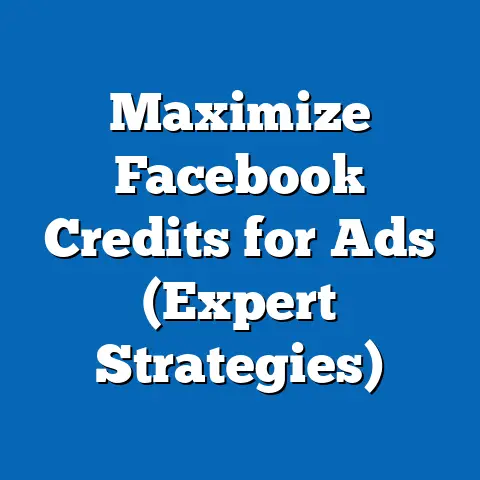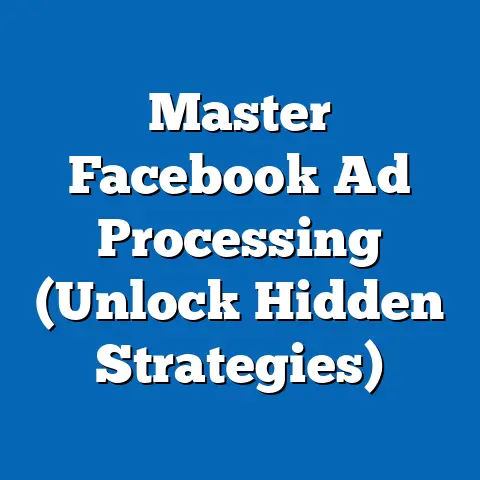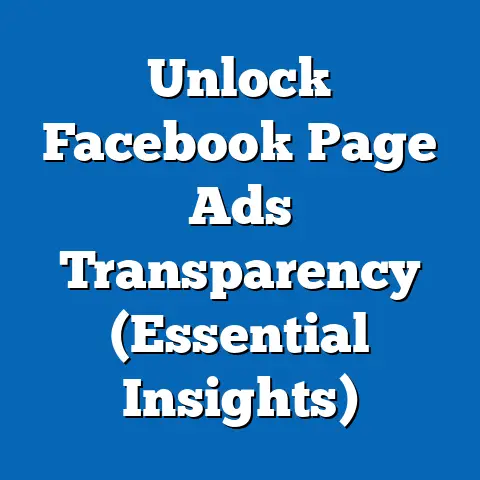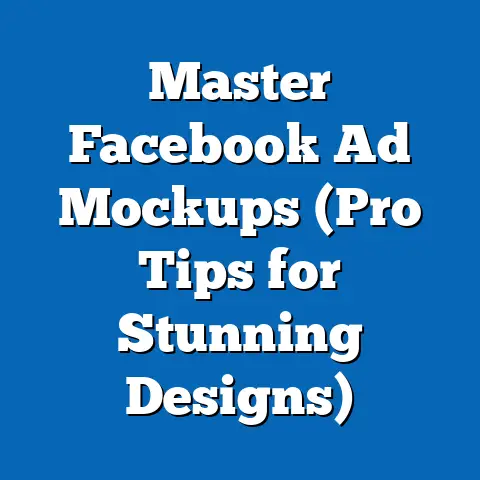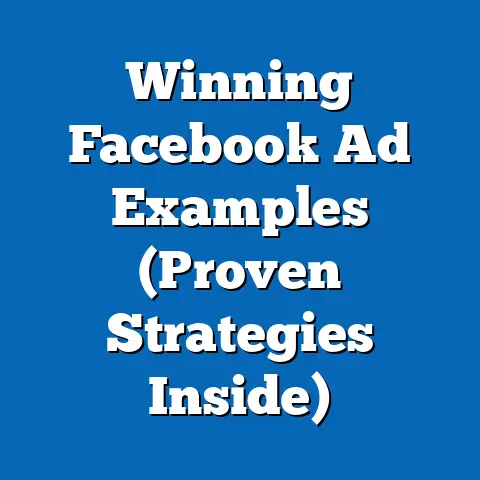Boost Local Sales with Winning Facebook Ads (Expert Secrets)
Boost Local Sales with Winning Facebook Ads: Expert Secrets
In today’s hyper-competitive marketplace, local businesses need every advantage they can get. The digital landscape is vast, but Facebook Ads can be your secret weapon for connecting with customers right in your neighborhood. We’re not just talking about running ads; we’re talking about strategically targeting your audience, crafting compelling content, and optimizing your budget for maximum impact. Forget complicated jargon and drawn-out strategies. This article is all about fast, actionable solutions you can implement immediately to see a real boost in local sales. I’ll walk you through understanding your audience, creating ads that resonate, mastering targeting, managing your budget, and measuring your success. Let’s get started!
Section 1: Understanding Your Local Audience
Before you spend a single penny on Facebook Ads, you need to understand who you’re trying to reach. Think of it like this: you wouldn’t open a bakery without knowing what kind of treats your neighbors crave, right? The same principle applies to advertising. Knowing your local market and customer demographics is absolutely crucial.
The Significance of Local Market Knowledge
Why is this so important? Because generic ads rarely work. People respond to messages that feel personal and relevant. By understanding your local market, you can tailor your ads to speak directly to the needs, interests, and pain points of your potential customers.
I remember when I first started working with a local coffee shop. Their initial ads were bland and generic, talking about “great coffee” and “friendly service.” Once we dug into their customer data, we discovered that their regulars were primarily young professionals and students who valued ethically sourced beans and a quiet workspace. We revamped the ads to highlight these specific aspects, and their engagement skyrocketed!
Tools and Techniques for Audience Research
So, how do you gain this crucial understanding? Here are some tools and techniques I’ve found invaluable:
- Facebook Audience Insights: This is your go-to tool within Facebook. It allows you to explore demographics, interests, behaviors, and even page likes of people connected to your page or within a specific location.
- Local Surveys: Don’t underestimate the power of direct feedback. Create a short online survey using tools like SurveyMonkey or Google Forms and offer an incentive (like a discount or freebie) for participation.
- Competitor Analysis: Take a look at your competitors’ Facebook pages. Who are they targeting? What kind of content are they posting? What kind of engagement are they getting? This can provide valuable insights into your own target audience.
- Google Analytics: If you have a website, Google Analytics can provide a wealth of information about your website visitors, including their location, demographics, and interests.
- Customer Relationship Management (CRM) data: If you already have a CRM system, you can leverage customer data like purchase history and demographics to understand what your local customers are buying, and what they might be interested in.
Quick Checklist for Defining Your Target Audience
To get you started, here’s a quick checklist to help you define your target audience:
- Age: What age range are you targeting?
- Gender: Are you targeting men, women, or both?
- Location: Be specific. Are you targeting a particular city, neighborhood, or radius around your business?
- Interests: What are their hobbies, passions, and interests?
- Behaviors: What are their online shopping habits? What kind of pages do they like? Are they frequent travelers?
- Education Level: What is the education level of your target customers?
- Income Level: What is the income level of your target customers?
Takeaway: Understanding your local audience is the foundation of a successful Facebook Ads campaign. Use the tools and techniques outlined above to gather data and create a clear picture of your ideal customer.
Section 2: Crafting Compelling Ad Content
Once you know who you’re talking to, it’s time to craft ad content that grabs their attention and compels them to take action. Think of your ad as a tiny billboard vying for attention in a crowded digital highway. It needs to be eye-catching, relevant, and persuasive.
Key Elements of Effective Ad Content
Effective ad content for local audiences hinges on a few key elements:
- Relevance: Your ad must be directly relevant to the needs and interests of your target audience.
- Clarity: Your message should be clear, concise, and easy to understand.
- Value Proposition: Clearly communicate the benefits of your product or service. What problem does it solve? Why should people choose you over the competition?
- Call to Action: Tell people exactly what you want them to do. “Shop Now,” “Learn More,” “Visit Our Store,” etc.
Tips for Writing Attention-Grabbing Headlines and Ad Copy
Here are some tips I’ve learned over the years for writing headlines and ad copy that resonate with local customers:
- Use High-Quality Images and Videos: Avoid blurry or pixelated images. Invest in professional photography or videography if possible.
- Showcase Your Products or Services: Use visuals that clearly showcase your products or services in an appealing way.
- Feature Local Landmarks: Incorporate local landmarks or scenery into your visuals to create a sense of place.
- Use Images of Real People: People respond to images of real people, especially if they can relate to them. Consider using photos of your staff or customers.
- A/B Test Your Visuals: Experiment with different images and videos to see what resonates best with your audience.
Examples of Successful Local Ad Campaigns
Let’s look at some real-world examples. I worked with a local brewery that wanted to increase foot traffic. We created a Facebook ad campaign featuring photos of their outdoor patio, highlighting their weekly live music events, and offering a discount on their signature beer. The ad copy read: “Enjoy live music and craft brews on our patio every Friday night! Show this ad for 10% off our [Signature Beer].” The campaign resulted in a significant increase in weekend foot traffic.
Another example involves a local bakery. They created a Facebook ad campaign showcasing their custom cake designs for birthdays and special occasions. The ad copy read: “Make your next celebration extra special with a custom cake from [Bakery Name]! Order yours today.” The campaign generated a surge in custom cake orders.
Takeaway: Compelling ad content is essential for capturing the attention of your local audience. Focus on relevance, clarity, value, and a strong call to action. Use high-quality visuals and local keywords to create a powerful and persuasive message.
Section 3: Targeting and Retargeting Strategies
You’ve got great ad content, but it won’t matter if you’re showing it to the wrong people. Targeting is all about ensuring your ads reach the individuals who are most likely to be interested in your products or services.
Facebook Ads Targeting Options
Facebook offers a wealth of targeting options, including:
- Location Targeting: Target people who live in, recently visited, or are traveling in a specific location.
- Demographic Targeting: Target people based on age, gender, education, relationship status, and other demographic factors.
- Interest Targeting: Target people based on their interests, hobbies, and pages they like.
- Behavior Targeting: Target people based on their online behavior, such as purchase history, device usage, and travel habits.
- Custom Audiences: Target people who have already interacted with your business, such as website visitors, email subscribers, or app users.
- Lookalike Audiences: Create audiences that are similar to your existing customers or website visitors.
Quick Strategies for Local Targeting
Here are some quick strategies for effective local targeting:
Think about it: these people have already shown an interest in what you have to offer. Retargeting is your opportunity to nudge them closer to a purchase.
I once worked with a local clothing boutique that implemented a retargeting campaign targeting website visitors who had viewed specific product pages but didn’t make a purchase. The ad featured the exact items they had viewed, along with a special discount code. The campaign resulted in a 20% increase in online sales.
Here’s how to set up a retargeting campaign:
- Install the Facebook Pixel: The Facebook Pixel is a small piece of code that you place on your website. It tracks visitor behavior and allows you to create custom audiences for retargeting.
- Create Custom Audiences: Create custom audiences based on website visitors, email subscribers, or app users.
- Create Retargeting Ads: Design ads that are specifically tailored to the people in your custom audiences. For example, you might show ads featuring the products they viewed on your website or offer a special discount to email subscribers.
Statistics and Case Studies
According to Facebook, retargeting campaigns have a 76% higher click-through rate than regular display ads. A case study by AdRoll found that retargeting campaigns can increase conversion rates by up to 150%.
Takeaway: Targeting and retargeting are essential for ensuring your ads reach the right people. Use Facebook’s targeting options to narrow your audience and create custom audiences for retargeting. This will help you maximize your ad spend and drive more local sales.
Section 4: Budgeting and Ad Bidding Strategies
Now that you know who you’re targeting and what kind of content to create, it’s time to talk about money. Setting a budget and choosing the right bidding strategy are crucial for maximizing your return on investment (ROI).
Setting a Budget That Maximizes ROI
There’s no one-size-fits-all answer to the question of how much to spend on Facebook Ads. It depends on your business goals, target audience, and the competitiveness of your local market. However, here are some straightforward approaches for setting a budget that maximizes ROI:
- Start Small: Begin with a small budget (e.g., $5-10 per day) and gradually increase it as you see results.
- Test Different Ad Sets: Create multiple ad sets with different targeting options and ad creatives. This will allow you to identify which combinations are most effective.
- Monitor Your Performance: Keep a close eye on your ad performance and adjust your budget accordingly. If an ad set is performing well, increase the budget. If it’s not, decrease the budget or pause the ad set altogether.
- Calculate Your Customer Lifetime Value (CLTV): Understanding how much a customer is worth to your business over their entire relationship is important for budgeting.
- Consider Your Profit Margin: Make sure your advertising budget is aligned with your profit margin. You don’t want to spend more on advertising than you’re making in profit.
Understanding Bidding Strategies
Facebook offers several different bidding strategies, including:
- Cost Per Click (CPC): You pay each time someone clicks on your ad. This is a good option if you’re focused on driving traffic to your website.
- Cost Per Impression (CPM): You pay for every 1,000 impressions (times your ad is shown). This is a good option if you’re focused on brand awareness.
- Cost Per Action (CPA): You pay when someone takes a specific action, such as making a purchase or filling out a form. This is a good option if you’re focused on generating leads or sales.
Which bidding strategy is best for local businesses? It depends on your goals. If you’re trying to drive foot traffic to your store, CPC might be a good option. If you’re trying to build brand awareness, CPM might be a better choice.
Tips for Monitoring Ad Performance and Adjusting Budgets
Here are some tips for monitoring ad performance and adjusting budgets:
- Use Facebook Ads Manager: Facebook Ads Manager provides a wealth of data about your ad performance, including impressions, clicks, conversions, and cost per result.
- Track Your Conversion Rates: Monitor your conversion rates to see how many people are taking the desired action after clicking on your ad.
- Calculate Your Return on Ad Spend (ROAS): ROAS is a key metric for measuring the effectiveness of your advertising campaigns. It tells you how much revenue you’re generating for every dollar you spend on ads.
- A/B Test Everything: Test different ad creatives, targeting options, and bidding strategies to see what works best.
- Don’t Be Afraid to Experiment: Facebook Ads is constantly evolving, so don’t be afraid to experiment with new features and strategies.
Takeaway: Budgeting and ad bidding strategies are crucial for maximizing your ROI. Start with a small budget, test different ad sets, monitor your performance, and adjust your budget accordingly. Choose the bidding strategy that aligns with your business goals and don’t be afraid to experiment.
Section 5: Measuring Success and Optimizing Campaigns
You’ve launched your Facebook Ad campaign, but the work doesn’t stop there. Measuring your success and optimizing your campaigns are essential for ensuring you’re getting the best possible results.
Essential Metrics to Track
Here are some essential metrics to track for local Facebook ad campaigns:
- Impressions: The number of times your ad is shown.
- Reach: The number of unique people who saw your ad.
- Clicks: The number of times people clicked on your ad.
- Click-Through Rate (CTR): The percentage of people who clicked on your ad after seeing it.
- Conversion Rate: The percentage of people who took the desired action after clicking on your ad (e.g., making a purchase, filling out a form).
- Cost Per Click (CPC): The average cost you paid for each click on your ad.
- Cost Per Conversion (CPC): The average cost you paid for each conversion.
- Return on Ad Spend (ROAS): The amount of revenue you generated for every dollar you spent on ads.
- Engagement Rate: The percentage of people who engaged with your ad (e.g., likes, comments, shares).
Fast Solutions for Analyzing Ad Performance
Facebook Ads Manager provides a wealth of data about your ad performance. Here are some fast solutions for analyzing your ad performance:
- Use the Facebook Ads Manager Dashboard: The dashboard provides a quick overview of your key metrics.
- Create Custom Reports: Create custom reports to track the metrics that are most important to your business.
- Use Facebook Analytics: Facebook Analytics provides deeper insights into your audience and their behavior.
- Export Your Data: Export your data to a spreadsheet for further analysis.
Quick Tips for Data-Driven Optimization
Here are some quick tips for making data-driven decisions to optimize your campaigns:
- Identify Your Top Performing Ads: Focus on the ads that are generating the best results and scale them up.
- Pause Your Underperforming Ads: Pause the ads that are not performing well and try something new.
- A/B Test Everything: Test different ad creatives, targeting options, and bidding strategies to see what works best.
- Refine Your Targeting: Continuously refine your targeting to reach the most relevant audience.
- Optimize Your Landing Pages: Make sure your landing pages are optimized for conversions.
- Use Retargeting: Retargeting is a powerful tool for re-engaging people who have already interacted with your business.
Takeaway: Measuring success and optimizing your campaigns are essential for maximizing your ROI. Track the key metrics, analyze your ad performance, and make data-driven decisions to improve your results.
Conclusion
Boosting local sales with Facebook Ads is absolutely achievable with the right strategies and a willingness to experiment. We’ve covered understanding your local audience, crafting compelling ad content, mastering targeting and retargeting, managing your budget effectively, and measuring your success. Remember, the key is to take immediate action. Start implementing these expert secrets today and watch your local sales soar.
Now go forth and conquer the Facebook Ads landscape! I’m confident that with these tips and a little bit of elbow grease, you’ll be well on your way to achieving your local sales goals. Good luck!

